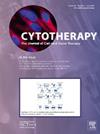既往免疫治疗对CAR - t细胞治疗b细胞急性淋巴细胞白血病(B-ALL)患者分离材料组成的影响
IF 3.7
3区 医学
Q2 BIOTECHNOLOGY & APPLIED MICROBIOLOGY
引用次数: 0
摘要
背景,AimCAR t细胞的功能依赖于用于制造的分离产物的组成,较高的总有核细胞(TNC)产量和平衡的CD4/CD8比率与改善的疾病反应相关。先前的免疫治疗对血浆成分的影响尚未确定。随着blinatumomab和inotuzumab等靶向药物越来越多地用于白血病治疗,了解这些药物如何影响血浆组成将对治疗计划非常重要。我们的目的是描述复发/难治性B-ALL患者blinatumomab和inotuzumab暴露与单采成分之间的关系。方法回顾性分析接受CAR - t细胞治疗试验(nct005442515, NCT03448393, NCT02315612)采血收集的复发或难治性B-ALL患儿和青年患者的数据。独立变量包括暴露于blinatumumab和/或inotuzumab治疗以及免疫治疗和单采之间的时间。排除免疫治疗后进行造血干细胞移植的患者。同时接受blinatumumab和inotuzumab治疗的患者根据最近端治疗进行分组(图1)。主要结果是每患者体重TNC产量(以公斤为单位)、CD3%和流式细胞术测量的CD4/CD8比率。使用Mann Whitney U检验比较结果。结果共114例患者,中位年龄为18岁(范围4-38岁),既往治疗5条线(范围2-13),基线疾病负担为骨髓原细胞1%(范围0 - 97%)。29例(25%)患者在中位5.1个月(范围1-58)时暴露于blinatumumab。22例(19%)患者在采血前中位3.4个月(范围1-30个月)接受过单抗治疗。布利纳单抗的暴露和时间与血浆成分的差异无关。相反,在采珠前的任何时间暴露于inotuzumab与较低的CD4/CD8比值相关(暴露者为0.77,未暴露者为1.11,p = 0.0047)(图2)。使用inotuzumab的时间不影响单采成分。TNC产率和CD3%与blinatumab或inotuzumab暴露没有差异。结论inotuzumab暴露可改变采血产品中CD4和CD8的比例,导致CD4/CD8比例降低,而blinatumumab未观察到相同的效果。更详细的表征免疫治疗后的t细胞表型和适应性将有助于指导采珠时间。本文章由计算机程序翻译,如有差异,请以英文原文为准。
The Impact of Prior Immunotherapy on Composition of Apheresis Material for CAR T-cell Therapy in Patients with B-Cell Acute Lymphocytic Leukemia (B-ALL)
Background & Aim
CAR T-cell functionality relies on the composition of the apheresis product used for manufacturing, with higher total nucleated cell (TNC) yield and balanced CD4/CD8 ratios associated with improved disease response. The impact of prior immunotherapy on apheresis composition has not been established. As targeted agents like blinatumomab and inotuzumab are increasingly used for leukemia therapy, an understanding of how these agents affect apheresis composition will be important for treatment planning.
Our aim was to describe the relationship between blinatumomab and inotuzumab exposure and apheresis composition in patients with relapsed/refractory B-ALL.
Methodology
Data from children and young adults with relapsed or refractory B-ALL who underwent apheresis collection for CAR T-cell therapy trials (NCT05442515, NCT03448393, NCT02315612) were analyzed retrospectively. Independent variables included exposure to blinatumomab and/or inotuzumab therapies and timing between immunotherapy and apheresis. Patients who had hematopoietic stem cell transplant following immunotherapy were excluded. Patients who received both blinatumomab and inotuzumab were grouped based on the most proximal therapy (Fig 1). Primary outcomes were TNC yield per patient weight in kilograms, CD3%, and CD4/CD8 ratios as measured by flow cytometry. Outcomes were compared using Mann Whitney U tests.
Results
A total of 114 patients with a median age of 18 years (range 4-38), 5 prior lines of therapy (range 2-13), and baseline disease burden of 1% blasts (range 0 to 97%) in bone marrow were evaluated. 29 (25%) patients had blinatumomab exposure at a median of 5.1 months (range 1-58). 22 (19%) had prior inotuzumab at a median of 3.4 months (range 1-30 mo) prior to apheresis.
Exposure to and timing of blinatumomab were not associated with differences in apheresis composition. In contrast, inotuzumab exposure at any time prior to apheresis was associated with a lower CD4/CD8 ratio (0.77 for those exposed vs 1.11 for those not exposed, p = 0.0047) (Fig 2). The timing of inotuzumab did not impact apheresis composition. TNC yield and CD3% did not differ with blinatumomab or inotuzumab exposure.
Conclusion
Inotuzumab exposure may alter CD4 and CD8 proportions in apheresis products, leading to decreased CD4/CD8 ratios, while the same effect was not observed with blinatumomab. More detailed characterization of T-cell phenotypes and fitness after immunotherapy will help guide apheresis timing.
求助全文
通过发布文献求助,成功后即可免费获取论文全文。
去求助
来源期刊

Cytotherapy
医学-生物工程与应用微生物
CiteScore
6.30
自引率
4.40%
发文量
683
审稿时长
49 days
期刊介绍:
The journal brings readers the latest developments in the fast moving field of cellular therapy in man. This includes cell therapy for cancer, immune disorders, inherited diseases, tissue repair and regenerative medicine. The journal covers the science, translational development and treatment with variety of cell types including hematopoietic stem cells, immune cells (dendritic cells, NK, cells, T cells, antigen presenting cells) mesenchymal stromal cells, adipose cells, nerve, muscle, vascular and endothelial cells, and induced pluripotential stem cells. We also welcome manuscripts on subcellular derivatives such as exosomes. A specific focus is on translational research that brings cell therapy to the clinic. Cytotherapy publishes original papers, reviews, position papers editorials, commentaries and letters to the editor. We welcome "Protocols in Cytotherapy" bringing standard operating procedure for production specific cell types for clinical use within the reach of the readership.
 求助内容:
求助内容: 应助结果提醒方式:
应助结果提醒方式:


